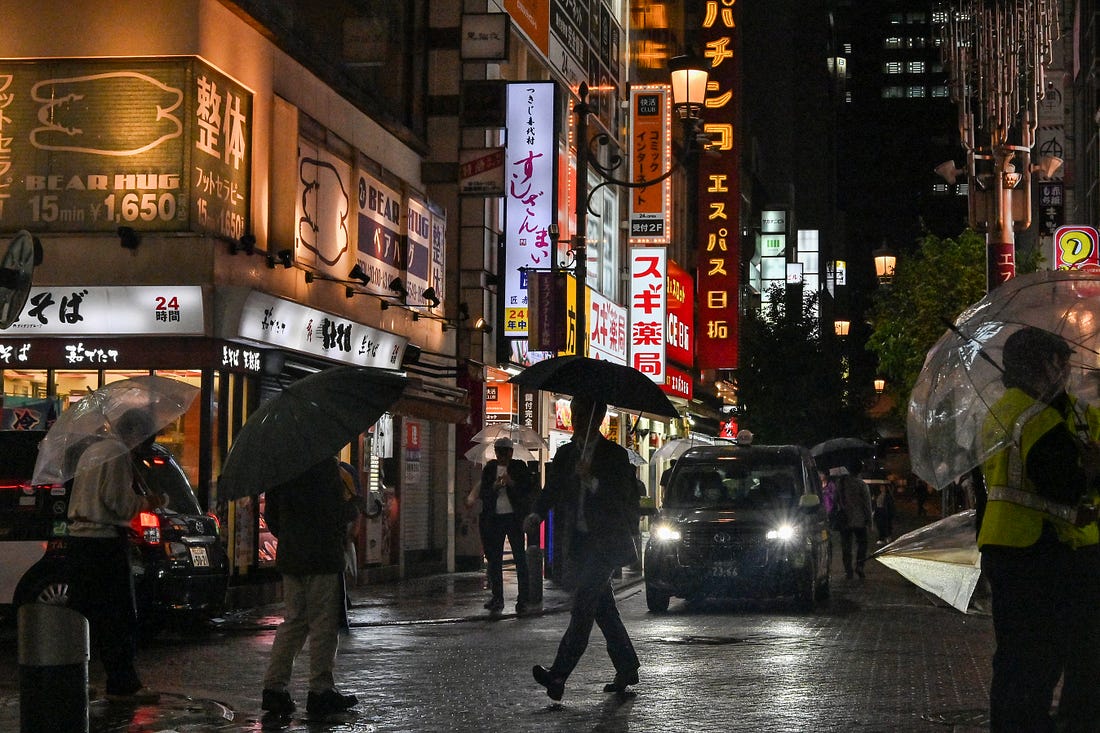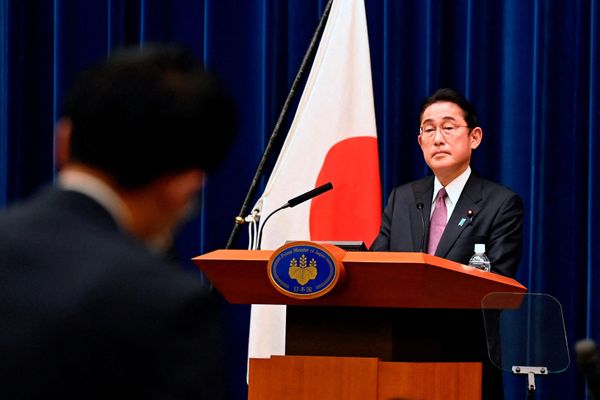In fifteen years raising a family in Montreal, it had never once occurred to usto move to Japan. Yes, my wife grew up in the Kyoto ‘burbs but she left in 2004 and had zero interest in going back. But “we make plans and God laughs,” the proverb says, and so it was in our case—a too-good-to-pass-up job opportunity came her way last summer, and we soon found ourselves packing up our lives and moving to a city we’d only known as tourists.
Six months on, here are ten observations on life here.
Tokyo is hyper-dense but not crowded. Even in the very center of town where we live—Nihonbashi—Manhattan-level density feels placid. The streets around our apartment are bordered by high rises and see plenty of foot traffic, but they always feel calm. The visual stereotype of white-gloved subway officials shoving commuters into hyper-crowded rail cars is two decades out of date: massive investment in new subway lines put an end to that years ago. Aside from a relatively small number of mega train stations, tourist hotspots and nightlife areas, Tokyo is calm.
How a compact metro area of 37 million people manages to feel this relaxed isn’t really a mystery: the city declared war on cars, and then won that war. Citywide, there are 0.32 cars per household, half the level in New York or London. Nothing is designed with the expectation that normal people own a car, because they don’t. Every shop that sells something too big to carry in a bag offers delivery. The streets are for pedestrians: every office, school, gym, hospital and shop is built on the assumption that you’ll walk there. There’s no on-street parking. Aside from main arterial roads, streets have no sidewalks: it’s fine to just walk right down the middle. Normal people don’t drive, road traffic is dominated by delivery vans, taxis and buses. Tokyo makes it easier, more convenient and cheaper not to own a car, so people don’t. Every service you might need is packed into even higher-density pockets right next to or on top of a train station. The result is an urban marvel: amazingly convenient, easy to navigate, and pleasant. Living here radicalizes you. Transit-centered hyper-density is just a smarter, more convenient, objectively better way to build a city than the car-choked messes we insist on in North America.
Of course, hyper-density requires compromises. In Tokyo’s compressed urban geometry, there’s just no room for some things I’d taken for granted. Bike parking racks. Small neighborhood parks. Ornamental flourishes. And the one that really gets me: street trees. Whole chunks of the city just don’t have any at all. This, I think, explains why Tokyo retains an oddly dystopian, Blade Runnerish vibe, despite being so calm and pleasant. You can’t go two blocks without seeing three convenience stores. But you can go days without seeing a tree.
The prime directive in Japanese society is “thou shalt not discomfit thy neighbor.” Ever. Even on trivial things. Prosocial behavior is a totalizing ideology. People take it seriously. A blanket taboo bans any behavior that might create any inconvenience to people around you, let alone—heaven forbid—open conflict. Kids get this ethos drilled into them intensively in school. The result is what you’d expect. There are no surprises. Everything and everyone is on time. Everyone is polite. Everything is clean. Everyone follows all the rules all the time. Everything works.
In the West, if you want to put someone at ease, you affect a plain, informal manner. Speak a little bit too politely and you come across as stiff, which turns the vibe frosty. In Japan, it works in exactly the opposite way. Polite language projects warmth and creates psychological comfort. Outside an intimate family setting, informal Japanese comes across as quite aggressive: it ends up hindering intimacy instead of enabling it. The hardest part of learning the language isn’t the language itself—though that’s quite hard, of course—but learning how to project warmth through politeness. I’m still bad at this.
To people in the West, Japan’s uncompromising insistence on prosocial behavior can come across as quite oppressive. The Japanese people I talk to don’t experience it that way. Quite the opposite. They can’t imagine how people elsewhere manage to get along without it. Or why they might want to try. In Japan, social interaction is very rarely ambiguous: what is expected of you is always explicit, always clear. My kids report that fitting in at school turned out to be strangely straightforward: there’s always a script. They just have to follow it. This is the opposite of stressful. You rarely have to think. Just follow the norm and you’re safe.
Democracy is a strange fit for a country this committed to prosocial behaviour. Politicians go to elaborate lengths to avoid criticizing each other too directly. The Liberal Democratic Party’s leadership race last year, which brought in the new prime minister Shigeru Ishiba, was a bizarre exercise in circumlocution—at least to me. Candidates leveled attacks at each other in ways so oblique that they would only register as an attack at all to those with encyclopedic background information about the race and each contender’s previous positions. If you have spent ten years obsessively following the comings-and-goings in Nagatachō—Tokyo’s Westminster—you could sort of squint and realize that the precise choice of words one candidate had used created a contrast with the expressed position of some rival candidate. Nobody would be so crass as to make the contrast explicit. Everybody understood it nonetheless. Japan has a democracy, but not as we know it.
If Tokyo is disconcertingly functional, that’s in part because it’s a parasitic organism sucking the life out of the rest of Japan. All the good jobs are here, all the opportunities, and so all the ambitious young people are here too. This one megacity is Japan’s New York, D.C. and LA all rolled into one. Living here, it’s easy to forget the huge demographic chaos Japan faces due to its collapsed birthrate and fast-aging population: stay in Tokyo and you’d never know the country has an acute shortage of young people. But the demographic shitshow is painfully evident the second you get out into Japan’s second- and third-tier cities: boarded-up shops, ghost neighborhoods, shuttered primary schools, abandoned houses: a Children of Men dystopia. The miraculous metropolis all around me thrives because the rest of Japan doesn’t. Every politician talks about this. None has a good idea for what to do about it.
Because Tokyo is so sleek and pleasant, it’s easy to forget that it sits at the center of a nation in long-term decline. Three decades of economic stagnation have seen Japan’s position on the world stage shrink dramatically from great power to afterthought. The yen is in the toilet: in dollar terms, incomes are worth a fraction of what they once were. People’s life prospects are dramatically constrained compared to where they were a generation ago. Nobody’s happy about it, but Japan has managed its decline rather elegantly: there’s little obvious poverty, no overt social conflict, very low unemployment, no such thing as a dangerous neighborhood. The hospitals work, old people are cared for, children are educated. It takes an extremely socially cohesive nation to pull it off, but living here gives you a sense that if all the cultural and political ingredients are in place, degrowth need not be a total catastrophe.
Xenophobes in the West sometimes point to Japan’s relative closure to immigration to explain its virtues. This is another outdated stereotype, like the guys shoving commuters into trains. Japan threw in the towel on its near-zero-immigration policy years ago, the government’s hand forced by the same demographic trends that have doomed its smaller cities and towns. There are quite a few workers from South Asia, Southeast Asia and Latin America here now, doing jobs that would otherwise go undone. Japanese people are pretty ambivalent about it, because we foreigners undermine the predictability that’s so central to society here. When a Japanese person is talking to another Japanese person, the script is clear. When they’re talking to a foreigner, it isn’t. Ambiguity creeps in, and unpredictability. Japanese people struggle with this. Partly in response, Tokyo is now full of English signage spelling out in very explicit language what is and what is not acceptable behavior. Do not smoke on this sidewalk. Behave properly in the subway even when you are very drunk. Do not speak loudly in the bicycle parking lot. And my favorite:
Obviously you don’t need to explain to Japanese people how to use the ritual cleansing vessels at a temple, but foreigners, well, they might make a mistake, so they better be told.
Listen, Japan doesn’t have a lot of experience playing host to foreigners, and they’re sort of groping their way towards a modus vivendi that doesn’t imperil the prosocial consensus. Keeping society predictable is what Japanese people are committed to. Because everything works here. Who’d want to imperil that?
Quico Toro is a contributing editor at Persuasion and writes the Substack One Percent Brighter.











